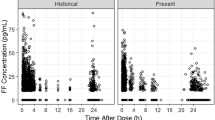Abstract
Different mixed-effects models were compared to evaluate the population dose–response and relative potency of two albuterol inhalers. Bronchodilator response was measured after ascending doses of each inhaler in 37 asthmatic patients. A linear mixed-effects model was developed based on the approach proposed by Finney for the evaluation of bioassay data. A nonlinear mixed-effects (Emax ) model with interindividual and interoccasion variability (IOV) in the different pharmacodynamic parameters was also fit to the data. Both methods produced a similar estimate of relative potency. However, the estimate of relative potency was 22% lower with the nonlinear mixed-effects model if IOV was not taken into account. Monte Carlo simulations based on a similar study design demonstrated that more biased and variable estimates of ED50 and relative potency were obtained when the nonlinear mixed-effects model ignored the presence of IOV in the data. Furthermore, the linear mixed-effects model that did not account for IOV produced confidence intervals for relative potency that were too narrow and thus could lead to erroneous conclusions. These problems were avoided when the estimation model could account for IOV. Results of the simulations were consistent with those of the experimental data. Although the linear or the nonlinear mixed-effects model may be used to evaluate population dose–response and relative potency, there are important differences in the assumptions made by each method.
Similar content being viewed by others
REFERENCES
L. B. Sheiner, S. L. Beal, and N. C. Sambol. Study designs for dose-ranging. Clin. Pharmacol. Ther. 46:63–77 (1989).
L. B. Sheiner. Leaning versus confirming in clinical drug development. Clin. Pharmacol. Ther. 61:275–291 (1997).
International Conference on Harmonization (ICH) Guideline for Industry. Dose-response information to support drug registration. Fed. Reg. 59:55972–55976 (1994).
D. J. Finney. Statistical Method in Biological Assay, Charles Griffin, London, 1978.
M. O. Karlsson and L. B. Sheiner. The importance of modeling interoccasion variability in population pharmacokinetic analyses. J. Pharmacokin. Biopharm. 21:735–750 (1993).
D. J. Schuirmann. A comparison of the two one-sided tests procedure and the power approach for assessing the equivalence of average bioavailability. J. Pharmacokin. Biopharm. 15:657–680 (1987).
A. J. Boeckmann, L. B. Sheiner, and S. L. Beal. NONMEM Users Guide Part V, NONMEM Project Group, University of California, San Francisco, 1994.
H. Akaike. A new look at the statistical model identification. IEEE Trans. Automat. Contr. 19:716–723 (1974).
R. C. Ahrens, J. B. Harris, G. Milavetz, L. Annis, and R. Ries. Use of bronchial provocation with histamine to compare the pharmacodynamics of inhaled albuterol and metaproterenol in patients with asthma. J. Allergy Clin. Immunol. 79:876–882 (1987).
P. J. Barnes and N. B. Pride. Dose-response curves to inhaled β-adrenoceptor agonists in normal and asthmatic subjects. Br. J. Clin. Pharmacol. 15:677–682 (1983).
W. R. Gillespie, S. G. Machado, D. J. Schuirmann, G. R. Zhu, A. H. Balch, and C. Hu. Bioequivalence assessment based on pharmacodynamic response: Application to albuterol metered-dose inhalers. Pharm. Res. 14:S-139 (1997).
M. O. Karlsson and L. B. Sheiner. Estimating bioavailability when clearance varies with time. Clin. Pharmacol. Ther. 55:623–637 (1994).
Author information
Authors and Affiliations
Rights and permissions
About this article
Cite this article
Lalonde, R.L., Ouellet, D., Kimanani, E.K. et al. Comparison of Different Methods to Evaluate Population Dose–Response and Relative Potency: Importance of Interoccasion Variability. J Pharmacokinet Pharmacodyn 27, 67–83 (1999). https://doi.org/10.1023/A:1020682729226
Published:
Issue Date:
DOI: https://doi.org/10.1023/A:1020682729226




